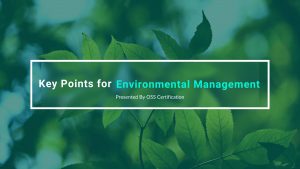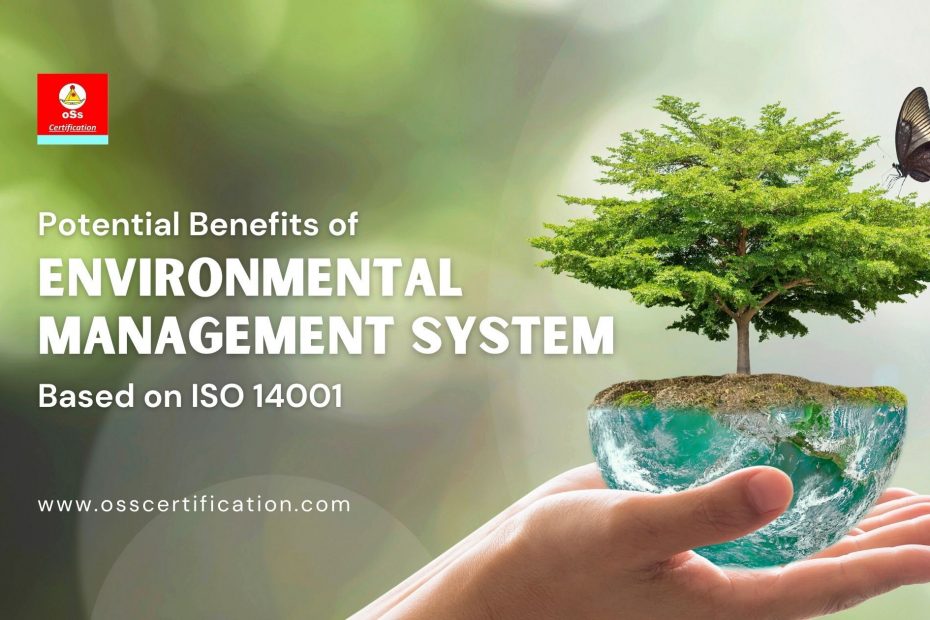An Environmental Management System based on ISO 14001 Standard (i.e., ISO 14001 Certification). Environmental Management is a necessity for the current economic, situation, urbanization, industrialization, consumer demand, change in Lifestyle, etc. Now environmental Management has become one of the global concerns. There are several potential benefits of Environmental Management system based on ISO 14001. When it was implemented effectively in the organization and got ISO 14001 Certification to continually keep UpToDate the compliance obligations and validate the effectiveness of EMS. Now it is the collective responsibility of all stakeholders of society to be proactive in Environmental Management.
As we know that natural resources are limited. The Key natural resources which are affecting our day-to-day life are -Land, water, Air, Plants, Flora, Fauna, & and many other natural resources, etc, so on. Which are necessary for the survival of human beings/ Living Things.
ISO 14001 is an Environmental Management System Standard, which was developed and published by an international organization of standardization (ISO), Geneva. The main objective of this EMS (Environmental Management System Standard) is to provide the framework requirements of Environmental management. All the requirements said in this ISO 14001 standard are generic (i.e Not specific to any Type/ size of the organization). Any organization wanted to further enhance its environmental performance; can adopt this EMS Standard for implementation in the organization, and also can get ISO 14001 Certification from an accredited ISO Certification Body (i.e OSS Certification).
This standard has several requirements for environmental management. where key focus specific to Environmental Management requirements are given below. Which can lead to potential benefits of an Environmental Management system based on ISO 14001 for further improvement of environmental performance. The organization that wanted to gain the benefits from this EMS standard can be more focused on a few specific EMS requirements in addition to other general management system requirements said in this ISO 14001 Standard.
The Key Focus points for Environmental Management
The Followings are the Key focus points of Environmental Management as given below
- Environmental Policy and Objective
- Identification of Environmental Aspects
- Environmental Aspects analysis and finding the Environmental Impact
- Utilizing a life cycle approach that can avoid environmental consequences from being mistakenly moved elsewhere within the life cycle, controlling, or influencing how the organization’s products and services are created, made, distributed, consumed, and disposed of
- Compliance obligations (Legal Requirement) and Evaluation of compliance
- Creating Awareness about Environmental Management and assigning responsibility
- Emergency Preparedness
- Environmental Performance Monitoring
Now further explained the Key Focus Points of Environmental Management for a better understanding of each point. Which Could help the organization for further implementation of Environmental Management in the organization. Also, the organization can visualize the potential benefits of an Environmental Management System Based on ISO 14001 and ISO Certification.

Environmental Policy and Objective
Environmental Policy is all about environmental performance-related aims and direction of an organization, as formally articulated by its top management. It is in form of the statement of Top Management with commitments towards Environmental performance – the commitments towards (but not limited)- fulfillment of Compliance Obligations, Environmental protections, prevention of pollution, enhancement of Environmental Management, etc.
Environmental Objective is set by the organization in consistent is Environmental Policy – in other words, the intended outcomes /Results. An objection is to be measurable so that it can be monitored from time to time, to see that the Environmental Policy of the organization is implemented and performing as per the set objective / Target.
Identification of Environmental Aspects, Aspects Impact Analysis, and finding the Environmental Impact
First, let us understand Environmental Aspects – (As per ISO 14001 standard terms & definition) An element of an organization’s activities or products, or services that interacts or can interact with the environment is known as the Environmental aspect. Which may have an impact on the environment.
Aspects Impact Analysis and Finding the Environmental Impact – Criteria and Methods established by the organization for Analysis of Environmental Impact to find out the Significant Environmental Aspects within the organization that is known as Environmental Aspects Impact Analysis.
Now further to understand in more detail about Identification of Environmental Aspects and Its Impact Analysis, take the case Study as an Example.
Case Study – Environmental Aspects and Impact Analysis.
Considering a manufacturing organization manufacturing the Fabricated Weeded Fuel Tank for Automobile – where several Machinery -such as Silting M/C, Power Press, Welding shop, Paint shop, etc so on. Also, Power Diesel Generator is installed in the organization for emergency use (when the Supply of Electricity break-down).
Now considering the above case, the following could be Environmental Aspects
- Noise (From Machines & Generators)
- Spillage the Lubricants from Machine & Generators
- Smoke From Generator
- Fumes (From Paint Shop and Weld shop)
- Consumption of Power
- Wastewater Discharge (From Plant – used in the Paint shop for degreasing, used by staff & workers)
- Land Contamination (due to spillage of Chemicals)
- Depletion of Natural Resources (use of Diesel and other chemicals)
- Waste Disposal (use of used Cloths and other Chemicals & Consumable)
Taking only a few examples of Aspects, of this case, there could be several other Environmental aspects that can be found in the above case. So, for an explanation, we have taken only a few.
So, looking into the above identified Environmental aspects of the organization – which are impacting the Environment leads to effect the environmental Conditions that cause Pollution.
Environmental Aspects Impact Analysis
To analyze the aspects, set the criteria of assessment, such as
Type of Activities – Direct / Indirect /Routine / Non-Routine
Conditions – Normal / Abnormal / Emergency
Environmental Impact – Air Pollution/ Water Pollution/ Soil Pollution/ Resource Depletion/ Noise Pollution/ Waste Management
Assessment Criteria (Example)
Quantity – Low -1, Moderate – 2, High -3
Occurrence – Rare -1, Once in a Week -2, Several Times in a Day – 4, Continuous – 5
Impact – Low -1, Discomfort -2, Resource Depletion-3, Affects Flora or Fauna – 4, Global Issue, Human health effect- 5
Assessment Criteria – QXOXI
Acceptance Level – When the results of QXOXI are equal or less than – 25
If the value is above – 25 it is treated as a Significant Environmental Aspect.
Now taking the Example we have set the Impact Assessment Criteria
Now doing the Aspects Impact analysis from above identified Environmental Aspects.
Environmental Aspects – Noise
Type of Activities – Direct and Routine Activities
Conditions – Abnormal
Environmental Impact – Noise Pollution
Quantity – High -3
Occurrence – Continuous – 5
Impact – Discomfort -2
Impact Assessment – 3x5x2 = 30
So after the Impact assessment, its value is 30, which is above the acceptance value – of 25. So, in this case, the Noise will be considered a Significant Environmental Aspect, which is causing Noise Pollution. Now the organization has to take necessary action to reduce the Noise Level in plants.
So by taking the above case study Example the organization can do the Environmental aspect Impact Analysis and Find the Signification of Environmental Aspects.
Utilizing a life cycle approach that can avoid environmental consequences from being mistakenly moved elsewhere within the life cycle, controlling or influencing how the organization’s products and services are created, made, distributed, consumed, and disposed of
Where the organization has to look into their products and work out. If the products are affecting the Environment during their life or after the end of life (during disposal). Then Re-design the products by changing the alternate raw material. So that the product does not affect the environment during life or after the end of its Life of Products. It can be easily recycled after the end of life or disposed of without creating any environmental effects.
Compliance obligations (Legal Requirement) and Evaluation of compliance
Where the organization has to identify the Applicable Legal requirements related to Environmental Management. Prepare the Legal Register and keep Legal Register up to date by adding amendments to the Legal requirement. In the Evaluation of compliance, the organization has to keep the compliance of Legal Requirements Along with its consent.
Creating Awareness about Environmental Management and assigning responsibility
Where the organization needs to provide the necessary Training on Environmental Management, Environmental Aspects, Compliance Obligations, Environmental policy & objectives. to all employees of the organization. Also, set the Role & responsibility of everyone in the organization for Environmental Management.
Emergency Preparedness
Where the organization has to identify potential emergency situations (such as – Fire, Earthquake, flood, etc) and develop a disaster management plan. Also, from time to time conduct mock drills to validate the preparedness.
Environmental Performance Monitoring
The organization from time to time monitor the various functions/process of the organization which is a significant aspect and keeps the data for monitoring the environmental performance. Generally, the following should be considered at least the environmental performance monitoring
- Significant Environmental Aspects
- Compliance Obligations
- Environmental Objectives
Potential Benefits of Environmental Management System
Once the Environmental Management System requirements are implemented. The organization may see the following potential Benefits of an Environmental Management System based on ISO 14001. During the Environmental Performance Monitoring.
- Impact of Significant Environmental Aspects reduced – results in reductions of Environmental Pollution
- Wastages of consumable / Raw material-controlled results in the reduction of wastages
- Reduction in Energy wastage
- Financial gain by re-designing products.
- Overall Environmental Management awareness improved
- Compliance Obligations (Legal requirements) Enhanced
How the organization can get ISO Certification (ISO 14001) after the implementation of EMS?
Once the organization implemented ISO 14001 Standard and conducted at least one full cycle EMS Internal Audit & Management Review meeting. The organization may apply for ISO Certification for ISO 14001 Standard to Accredited ISO Certification Body (i.e OSS Certification) to get ISO 14001 Certification. Certification Body after receipt of the Application and performing the onsite Audit, the ISO 14001 Certification may award to the applicant organization.
Most recommended ISO Standard along with ISO 14001 Certification.
As per the Industry expert view, when the organization is planning for Integrated Management System Certification (IMS Certification). Then it is recommended that ISO 9001 Certification along with ISO 14001 Certification for the organization. Where the organization can have the several benefits – such as
- The time of Implementation for Two standards is less as compared to the Individual standard.
- Common Resources can be used
- The cost of Certification and Cost of Implementation reduced
- Common Integrated Documents can be used for Both Standards (Except for Some Specific Requirements)
So, when the organization is planning Integrated Management System Certification (IMS Certification). Then the organization can choose ISO 9001 Certification along with ISO 14001 Certification.
Also read- A Complete Guide for ISO 14001 Certification for Beginners
